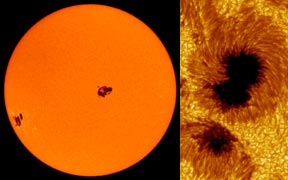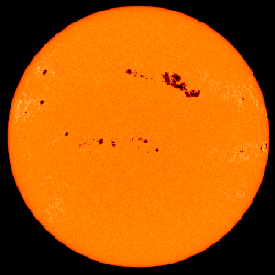The Sun on March 30, 2001. You can see the huge sunspot in the upper, right hand part of the Sun. Though it doesn't look like much, this area is equivalent to the surface area of 14 Earths! The sunspot has since moved so that it is on the far side of the Sun from Earth.
Click on image for full size
Courtesy of Spaceweather.com
Massive Sunspot! (Updated!)
News story originally written on April 4, 2001
There is a huge sunspot on the the Sun right now. It is the biggest in 10 years!
It let off the largest solar flare and coronal mass ejection (CME) in ten years on Monday, April 2!
This flare and CME won't hit Earth directly. But, there's still a good chance you'll be able to see the auroral lights the nights of April 4th-5th. To see the aurora, you just need a clear, dark night.
Good luck and stay tuned to Spaceweather.com for updates!
You might also be interested in:

Sunspots are dark spots on the Sun. They may look small, but they are actually as bigas a planet like Earth or Mars! Sunspots are "dark" because they are colder than the areas around them. Of course, they
...more
It was another exciting and frustrating year for the space science program. It seemed that every step forward led to one backwards. Either way, NASA led the way to a great century of discovery. Unfortunately,
...more
The Space Shuttle Discovery lifted off from Kennedy Space Center on October 29th at 2:19 p.m. EST. The sky was clear and the weather was great. This was the America's 123rd manned space mission. A huge
...more
Scientists found a satellite orbiting the asteroid, Eugenia. This is the second one ever! A special telescope allows scientists to look through Earth's atmosphere. The first satellite found was Dactyl.
...more
The United States wants Russia to put the service module in orbit! The module is part of the International Space Station. It was supposed to be in space over 2 years ago. Russia just sent supplies to the
...more
A coronal mass ejection (CME) happened on the Sun last month. The material that was thrown out from this explosion passed the ACE spacecraft. ACE measured some exciting things as the CME material passed
...more
Trees and plants are a very important part of this Earth. Trees and plants are nature's air conditioning because they help keep our Earth cool. On a summer day, walking bare-foot on the sidewalk burns,
...more















